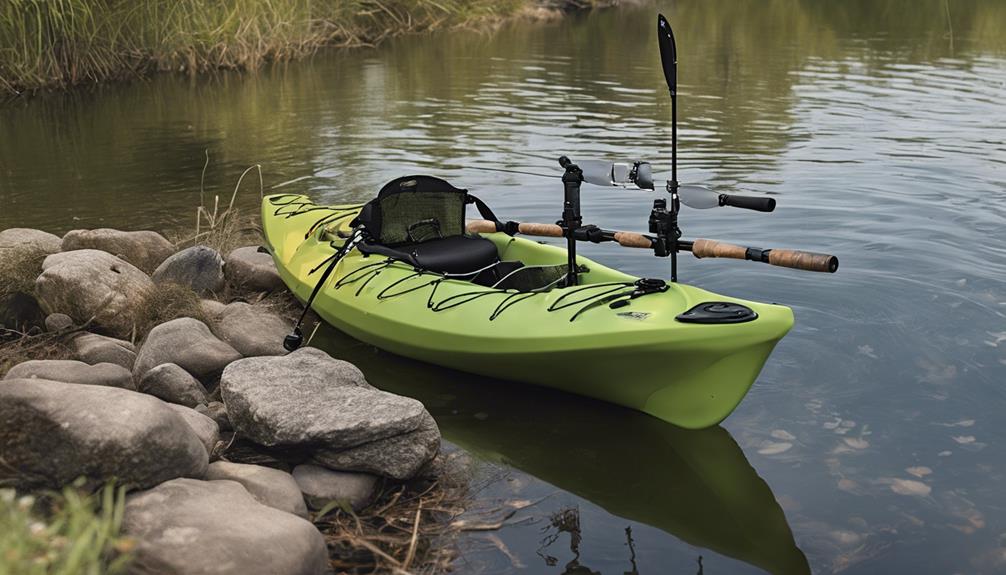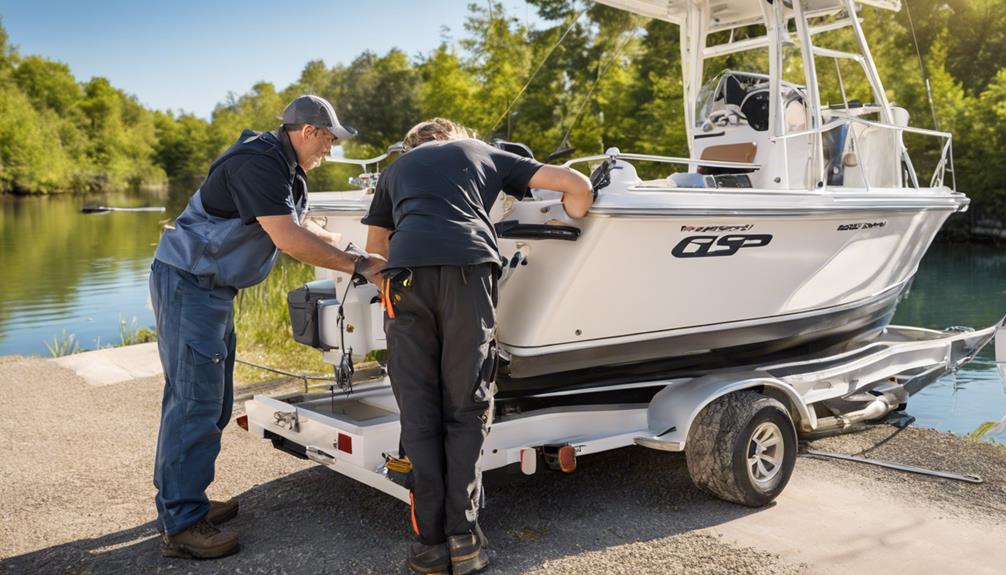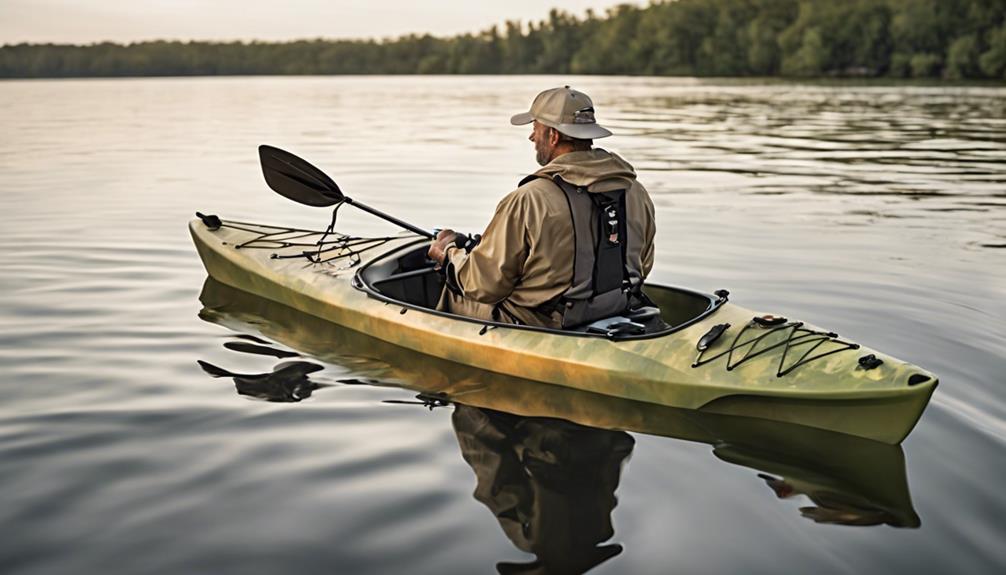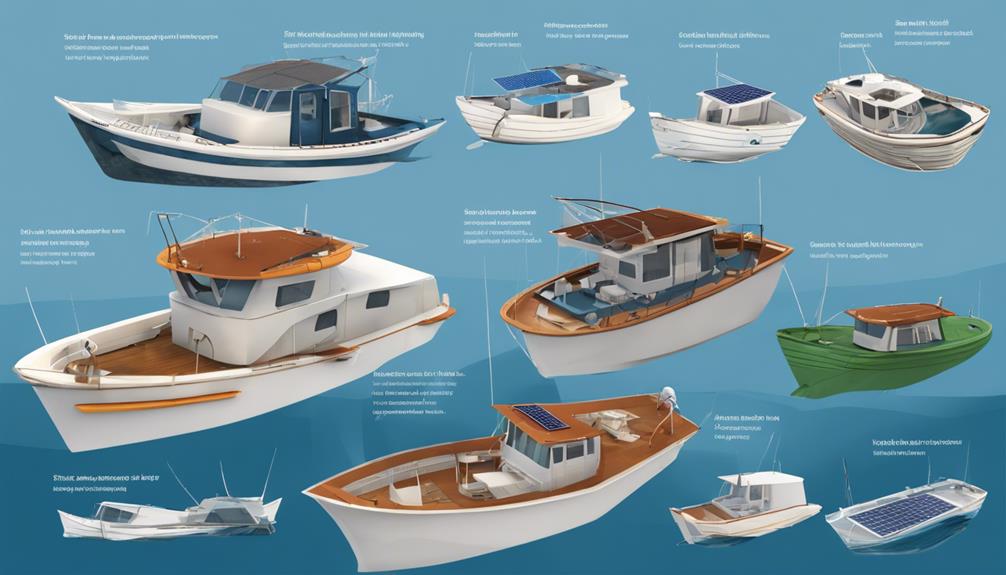When preparing for a successful kayak fishing trip, selecting the right kayak, choosing the appropriate paddle, securing a reliable fishing rod holder, and wearing a suitable personal flotation device are paramount. Each of these key pieces of gear plays a crucial role in ensuring your safety, comfort, and efficiency while out on the water.
But there are more tools and accessories that can elevate your kayak fishing experience to the next level. Find out how these additional essentials can make a significant difference in your angling pursuits.
Kayak Selection
When choosing a kayak for fishing, prioritize stability and maneuverability over speed. The stability comparison among kayaks is crucial to ensure you can easily stand up to cast your line without the fear of tipping over. Look for kayaks with a high weight capacity as they tend to be more stable in the water. A higher weight capacity also means you can bring along more gear without compromising stability.
In terms of maneuverability features, opt for kayaks with good tracking ability. This will help you navigate through different water conditions with ease. Additionally, kayaks with responsive rudders or skegs can enhance your maneuvering capabilities, especially in windy conditions or strong currents.
When it comes to storage options, look for kayaks with ample space for your fishing gear. Consider kayaks with built-in storage compartments, bungee cords for securing items, and attachment points for accessories like rod holders or fish finders.
Paddle Choice
For kayak fishing, selecting the right paddle is essential for efficient maneuvering and propelling your kayak through the water. When choosing a paddle, consider the blade material and weight. Lightweight materials like fiberglass or carbon fiber are excellent choices as they reduce fatigue during long fishing trips. The blade design also plays a crucial role in how efficiently you can paddle, with wider blades providing more power but requiring more effort.
Shaft length is another important factor to consider. The shaft should be long enough to comfortably reach the water without straining your arms or back. Additionally, the grip style can significantly impact your paddling experience. Some paddles offer adjustable grips that allow you to customize the angle for better ergonomics, reducing the risk of wrist fatigue.
When kayak fishing, you want a paddle that strikes the right balance between weight and durability. A lightweight paddle will be easier to handle for extended periods, but it should also be sturdy enough to withstand the rigors of fishing in different water conditions. By carefully considering blade material, weight, shaft length, and grip style, you can find a paddle that enhances your kayak fishing experience.
Fishing Rod Holder
Selecting a sturdy fishing rod holder is crucial for securing your equipment while kayak fishing. When it comes to rod storage on your kayak, having a reliable holder can make all the difference in ensuring your rods stay in place while you navigate the waters. Proper kayak setup includes positioning the rod holder within easy reach and at a convenient angle for quick access when you get a bite.
When choosing a fishing rod holder for your kayak, consider one that's specifically designed for marine use. Look for holders that are durable, rust-resistant, and adjustable to fit different rod sizes. Mounting options vary, with some holders designed to attach to specific kayak models or outfitted with adjustable mounts for more flexibility in placement.
Ensure that the rod holder you select is compatible with your kayak setup. Depending on the type of fishing you plan to do and the layout of your kayak, you may opt for flush mount rod holders, which sit level with the kayak deck, or adjustable rod holders that can be positioned for optimal fishing comfort. Experiment with different placements to find the setup that works best for you before heading out on the water. A secure and well-placed fishing rod holder is a valuable addition to your kayak fishing gear.
Personal Flotation Device
Choosing a reliable personal flotation device is essential for your safety while kayak fishing. When selecting the right one, consider factors such as proper fit, comfort, safety features, and styles and designs to ensure a pleasant and secure fishing experience.
Here are three key points to keep in mind while choosing a personal flotation device:
- Proper Fit: Your PFD should fit snugly around your chest and torso to prevent it from riding up while you're on the water. Look for adjustable straps and sizing guides to find the perfect fit for your body type.
- Comfort: Opt for a PFD that allows for freedom of movement, especially in the arms and shoulders, to ensure you can paddle and cast comfortably. Breathable materials and padded straps can enhance your overall comfort during long hours on the water.
- Safety Features: Look for PFDs with added safety features such as reflective strips, whistle, and bright colors for visibility. Some PFDs also come with pockets for storing essentials like a knife or whistle, adding an extra layer of safety to your fishing trips.
Tackle Storage Solutions
Consider organizing your tackle efficiently with smart storage solutions to optimize your kayak fishing experience. Waterproof bags are a must-have when it comes to storing your tackle securely and keeping it dry throughout your fishing trip. These bags come in various sizes and styles, allowing you to choose the ones that best fit your needs. They can be easily stowed away in the storage compartments of your kayak, ensuring easy access to your tackle whenever needed.
Rod holders are another essential storage solution for kayak fishing. These holders can be attached to different parts of your kayak, such as the sides or the back, providing a safe and convenient spot to store your fishing rods when not in use. This helps prevent your rods from getting tangled or damaged during your kayak adventures. Additionally, rod holders free up your hands, allowing you to focus on paddling or handling your catch without worrying about where to place your rods.
Anchoring System
For a secure and stable setup during your kayak fishing excursions, outfitting your kayak with a reliable anchoring system is crucial. Here are some key considerations to keep in mind when setting up your anchoring system:
- Anchor Types and Installation:
- Choose an anchor type that suits the water conditions you typically fish in.
- Common options include grapnel anchors, folding anchors, and stakeout poles.
- Ensure proper installation by attaching the anchor trolley system to the bow and stern of your kayak for maximum control over anchoring position.
- Anchoring Techniques and Maintenance:
- Practice different anchoring techniques such as the traditional bow and stern anchoring, or the anchor trolley method for positioning your kayak precisely.
- Regularly check your anchor line for wear and tear, and replace it when necessary.
- Keep your anchor clean and free of debris to prevent malfunctions during use.
Fish Finder/GPS

Enhance your kayak fishing experience with a reliable Fish Finder/GPS system. When out on the water, having a Fish Finder/GPS can significantly improve your fishing efficiency. These devices use sonar technology to help you locate fish beneath the surface, making it easier to find the perfect fishing spots. Additionally, the navigation capabilities of a Fish Finder/GPS ensure you can easily return to shore or navigate unfamiliar waters with confidence.
One of the key features of a Fish Finder/GPS is its mapping capabilities. These devices come equipped with detailed maps that allow you to mark productive fishing locations, track your routes, and avoid hazards. The mapping features enable you to plan your fishing trips more effectively and maximize your time on the water.
Furthermore, a Fish Finder/GPS provides valuable depth readings, giving you crucial information about the underwater terrain. By knowing the depth of the water and any underwater structures, you can adjust your fishing techniques accordingly and increase your chances of a successful catch.
Investing in a Fish Finder/GPS for your kayak fishing adventures is a wise decision. With its sonar technology, navigation aids, mapping features, and depth readings, this essential gear won't only enhance your fishing experience but also help you become a more skilled angler.
Safety Whistle and Light
Make sure to have a safety whistle and light readily accessible while kayak fishing for added security in case of emergencies. Safety equipment like a whistle and light are essential visibility tools that can help you attract attention and stay safe on the water.
Here are three crucial items to consider for your safety while kayak fishing:
- Safety Whistle: A safety whistle is a small but powerful tool that can be heard over long distances. In case of an emergency, such as getting separated from your group or needing assistance, a whistle can help you signal for help effectively. Make sure to attach it to your life jacket or PFD for quick access.
- Water-Activated Light: A water-activated light is another vital piece of safety equipment. This type of light turns on automatically when it comes in contact with water, making it ideal for low-light conditions or emergencies. Having a light source can make you more visible to other boaters or rescuers.
- Strobe Light: A strobe light is a high-intensity flashing light that increases your visibility in low light or foggy conditions. Attaching a strobe light to your kayak or life jacket can help others spot you from afar, especially in situations where visibility is poor. Remember, being visible on the water is crucial for your safety.
Frequently Asked Questions
How Do I Properly Secure My Kayak to My Vehicle for Transportation to the Fishing Spot?
To properly secure your kayak to your vehicle for transportation to the fishing spot, you should use kayak tie downs and follow safety precautions.
Start by placing your kayak on the roof rack, making sure it's centered. Use straps to secure the kayak to the rack, looping them through the handles and around the bars.
Double-check that everything is tight and secure before hitting the road to avoid any mishaps.
Are There Any Specific Maintenance Tips for Keeping My Fishing Rod Holder in Good Condition?
To keep your fishing rod holder in top condition, follow these cleaning tips and storage solutions.
Regularly clean the holder with a mild soap and water solution to remove dirt and salt buildup. Ensure it's completely dry before storing to prevent mold growth.
Store your rod holder in a weather-protected area when not in use to shield it from harsh elements.
Taking these simple steps will help prolong the life of your rod holder.
What Should I Do in Case of an Emergency While Kayak Fishing Alone?
If you encounter an emergency while kayak fishing solo, prioritize safety. Implement emergency procedures, such as signaling for help using a whistle or flares.
Prior to your outing, ensure you've communicated your plans with someone on land. Always wear a life jacket and conduct a risk assessment before setting out.
Can I Use a Regular Cooler for Storing My Bait and Catch, or Do I Need a Specialized Tackle Storage Solution?
You can use a regular cooler for storing your bait and catch, but a specialized tackle storage solution might be more convenient for tackle organization. A regular cooler can work for bait storage, but a tackle box is designed specifically for organizing your gear efficiently.
Consider your needs and preferences when deciding between a regular cooler and a specialized tackle storage solution for your kayak fishing trips.
How Can I Best Protect My Electronic Fish Finder/Gps From Water Damage While Out on the Water?
To shield your electronic fish finder/GPS from water damage, invest in waterproof cases. Tether them securely to your kayak to prevent accidental drops.
Consider moisture protection and storage solutions, like dry bags or containers with sealing lids. These measures will help safeguard your valuable electronics, ensuring they stay functional and dry during your kayak fishing adventures.
Conclusion
In conclusion, make sure you have the top 4 essential gear for kayak fishing:
- a reliable kayak
- a good paddle
- a fishing rod holder
- a personal flotation device.
These items will ensure you have a safe and enjoyable fishing experience on the water.
Don't forget to also consider:
- tackle storage solutions
- an anchoring system
- a fish finder/GPS
- safety whistle and light for added convenience and safety.
Happy fishing!



